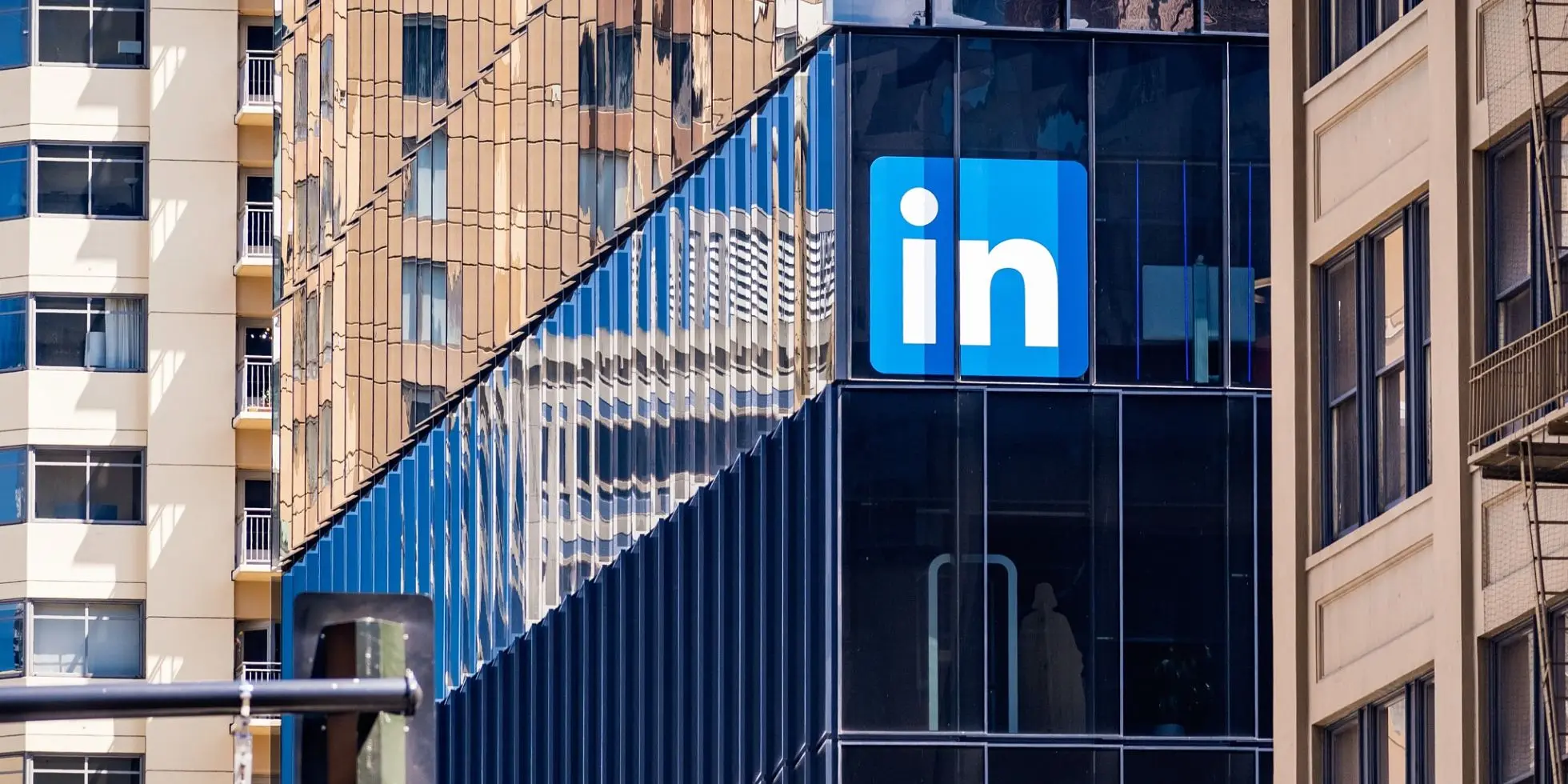Even just a few years ago, one would have laughed if someone said that LinkedIn has the potential to be an advertising platform. Professionals were using it only for networking.
But as we have stepped into 2025, that isn’t the case anymore. LinkedIn has been turning into the go-to channel for B2B brands and marketers looking to reach decision-makers.
While Facebook and Instagram target users based on interests and behaviors, LinkedIn lets businesses connect directly with professionals, executives, and key stakeholders. It’s the difference between hoping the right person sees your ad and knowing you’re in front of them.
But what makes LinkedIn so powerful? 80% of B2B leads come from LinkedIn Ads, and the platform boasts conversion rates 3x higher than other social networks. Unlike broad consumer advertising, LinkedIn’s ad system is designed for business growth and allows startups and businesses to target users based on job titles, company size, industry, and professional expertise.
However, LinkedIn Ads can be a bit costly compared to Google and Facebook. As a result, if you run a campaign without a clear strategy, your budget will burn fast and leave you with a high spend and no result. LinkedIn advertising success is more about following the right LinkedIn advertising strategy, which includes choosing the right format, refining your targeting, optimizing creative, and continuously iterating based on performance data.
This guide breaks down exactly how to run LinkedIn Ads that work. You’ll learn:
- Which ad types deliver results.
- How to fine-tune audience targeting.
- What makes high-converting ad creatives.
- Real-world case studies of the perfect LinkedIn advertising strategy
By the end, you won’t just know how to run LinkedIn Ads; you’ll know how to scale them into a system that brings in revenue and builds a better qualified lead pipeline.
LinkedIn ad types and their best use cases
The best part about advertising on LinkedIn is the variety it offers in terms of ad formats. Not all businesses prefer the same approach when it comes to LinkedIn marketing and having multiple options — each tied back to different ad business objectives — offers a certain leverage to these companies. Let’s explore the types:
1. Sponsored content
Sponsored content is a native advertising format that appears directly within a user’s LinkedIn feed, just like an organic post. These ads blend in with LinkedIn’s regular content, making them one of the most practical and engaging ad types for generating awareness and nurturing leads.
Types
- Single image ads: These ads use a high-quality image with a concise text description and a strong call-to-action (CTA).
- Video ads: Short-form videos work well for brand storytelling, product demonstrations, and event promotions.
- Carousel ads: These ads allow multiple images in a swipe-through format, making them ideal for step-by-step guides, multi-product showcases, or case studies.
Best use cases
- Brand awareness campaigns targeting top-of-funnel prospects.
- Lead generation when paired with LinkedIn’s Lead Gen Forms.
- Content distribution for whitepapers, reports, and blog posts.
- Product and service promotions that educate potential buyers.
Best practices
- Use high-contrast images that capture attention.
- Keep ad copy concise, ideally under 150 characters for headlines.
- Include a clear CTA, such as Download Now, Sign Up, or Get a Demo.
- A/B test different ad creatives and messaging to find what resonates best.
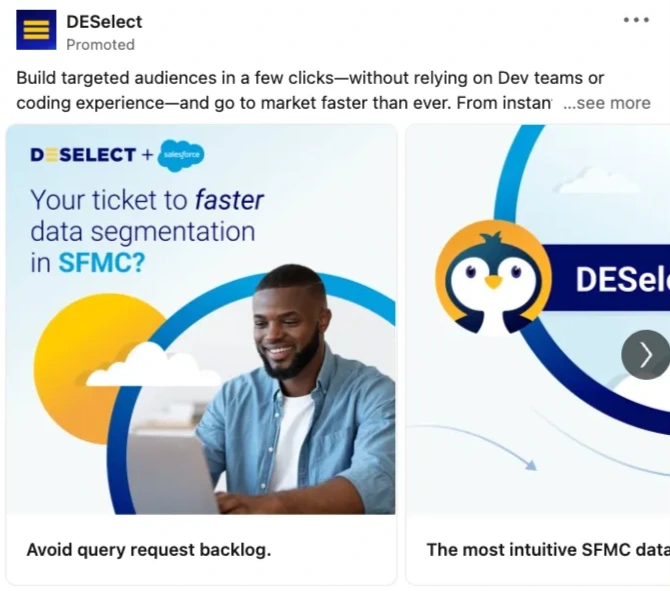
Carousel ad - one type of LinkedIn sponsored ads
2. Sponsored messaging (Message Ads and Conversation Ads)
Sponsored messaging, also known as Message ads and Conversation ads, allows advertisers to send personalized messages directly to a user’s LinkedIn inbox. These ads are highly targeted and can feel more personal compared to feed-based ads.
Types
- Message ads: These are one-time direct messages that land in the recipient’s inbox, often used for event invitations, whitepaper downloads, or product pitches.
- Conversation ads: These allow users to engage in an interactive chatbot-like conversation where they can select pre-set responses, guiding them toward relevant actions.
Best use cases
- Account-based marketing (ABM) campaigns targeting specific high-value prospects.
- Webinar and event invitations sent to relevant professionals.
- B2B lead generation through highly personalized messaging.
Best practices
- Use a personalized greeting with the recipient’s name and job title.
- Keep the message short and value-driven (avoid sales-heavy language).
- Add a clear and action-oriented CTA (e.g., “Join Our Free Webinar”).
- Limit frequency, as excessive messaging can feel intrusive.
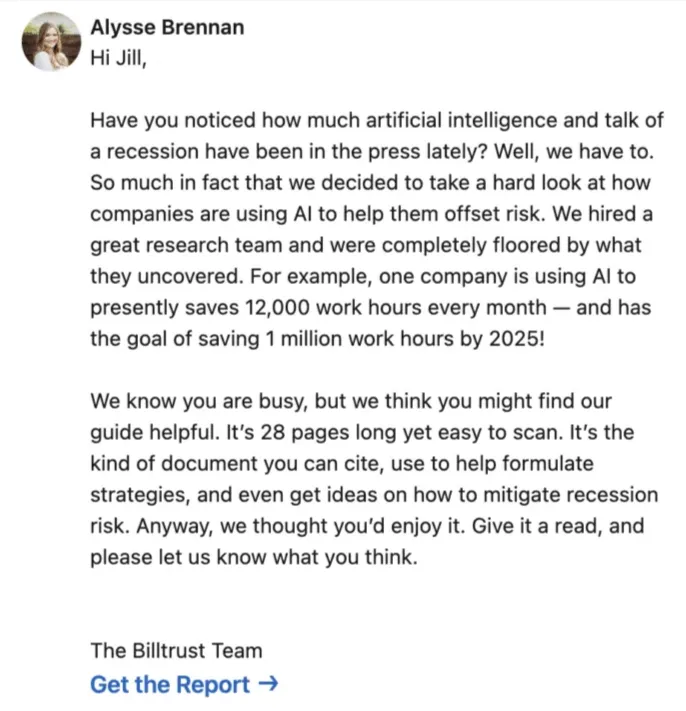
An example of LinkedIn Message Ads
3. Text ads
Text ads are simple, low-cost pay-per-click (PPC) ads that appear on the right-hand sidebar of LinkedIn’s desktop experience. They consist of a headline, a short description, and a small image.
Best use cases
- Budget-conscious advertisers looking for cost-effective brand exposure.
- Driving traffic to landing pages or blog content.
- A/B testing before scaling with more expensive ad formats.
Best practices
- Keep the headline under 75 characters for clarity.
- Use a bold CTA (e.g., “Try Free for 14 Days”).
- Test different ad variations to optimize click-through rate (CTR).
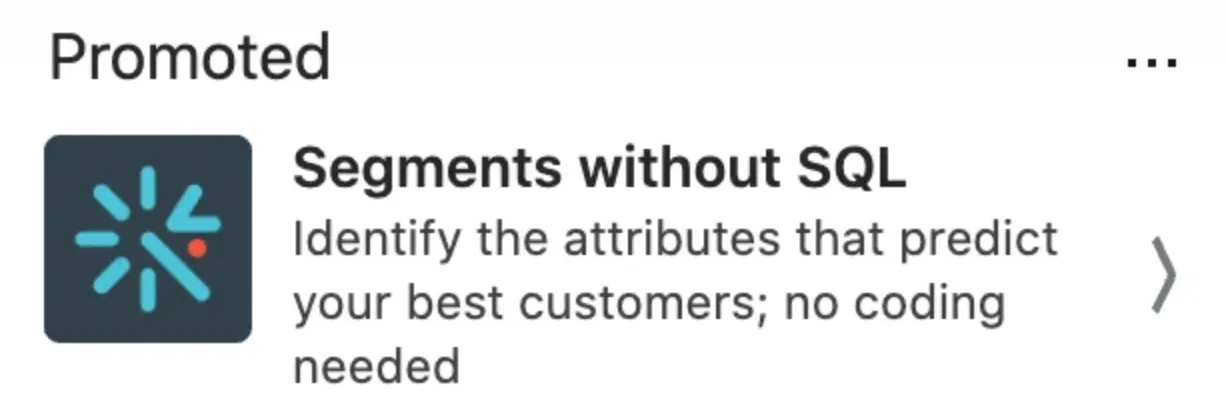
Examples of LinkedIn Text Ads
4. Dynamic ads
Dynamic ads personalize the ad experience by pulling data from the LinkedIn profile of the viewer. These ads can include the user’s profile picture, job title, and company logo, making them more engaging and relevant.
Best use cases
- Retargeting campaigns that bring visitors back to your website.
- Event promotion by targeting attendees based on job roles.
- Employer branding campaigns to attract job applicants.
Best practices
- Personalization works best for high-value prospects in ABM campaigns.
- Test different CTA variations to find the highest-performing copy.
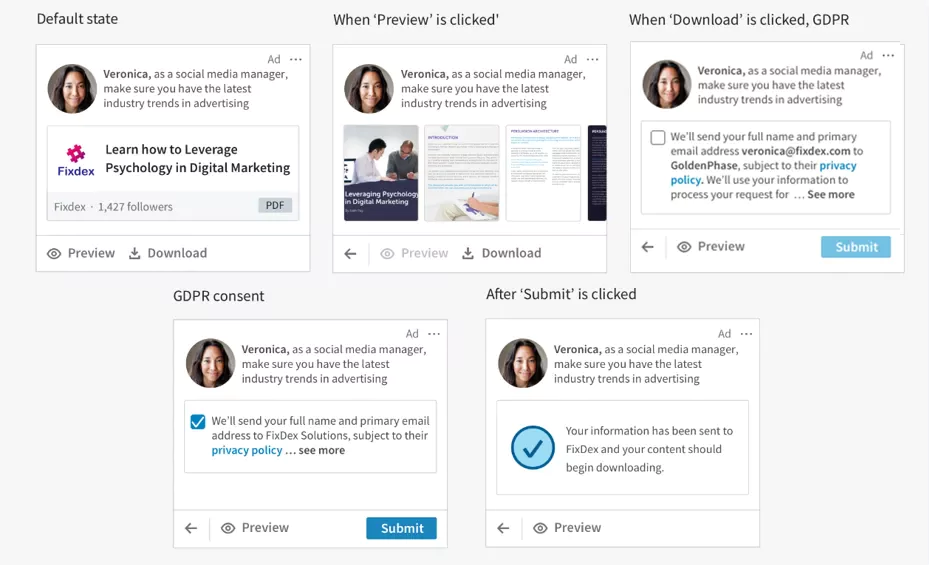
Different stages of interacting with Dynamic Ads
5. Lead gen forms
Lead Gen Forms allow users to submit pre-filled forms directly within LinkedIn, reducing friction and increasing conversion rates.
Best use cases
- B2B lead generation for whitepapers, reports, and case studies.
- Demo and consultation sign-ups for SaaS and service businesses.
- Webinar registrations with seamless sign-up experiences.
Best practices
- Use fewer form fields (First Name, Last Name, Email, Job Title work best).
- Offer a clear value exchange, such as a free report or exclusive insights.
- Follow up with a nurture email sequence to keep leads engaged.
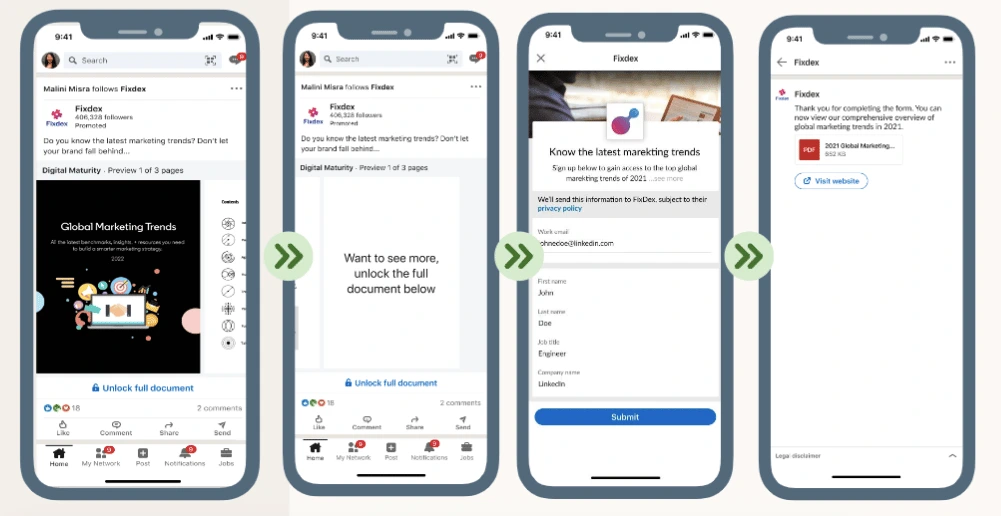
How interacting with a Lead Gen Ad looks like
6. Thought leadership ads
Thought leadership ads position your brand as an industry authority by promoting insightful content, expert opinions, and strategic narratives.
Best use cases
- Showcasing original research, industry trends, or expert insights.
- Highlighting executive viewpoints to build credibility and influence.
- Engaging decision-makers with forward-thinking perspectives.
Best practices
- Focus on high-value, data-driven content that educates and informs.
- Use compelling headlines that provoke curiosity and discussion.
- Encourage engagement by asking thought-provoking questions or sharing unique insights.
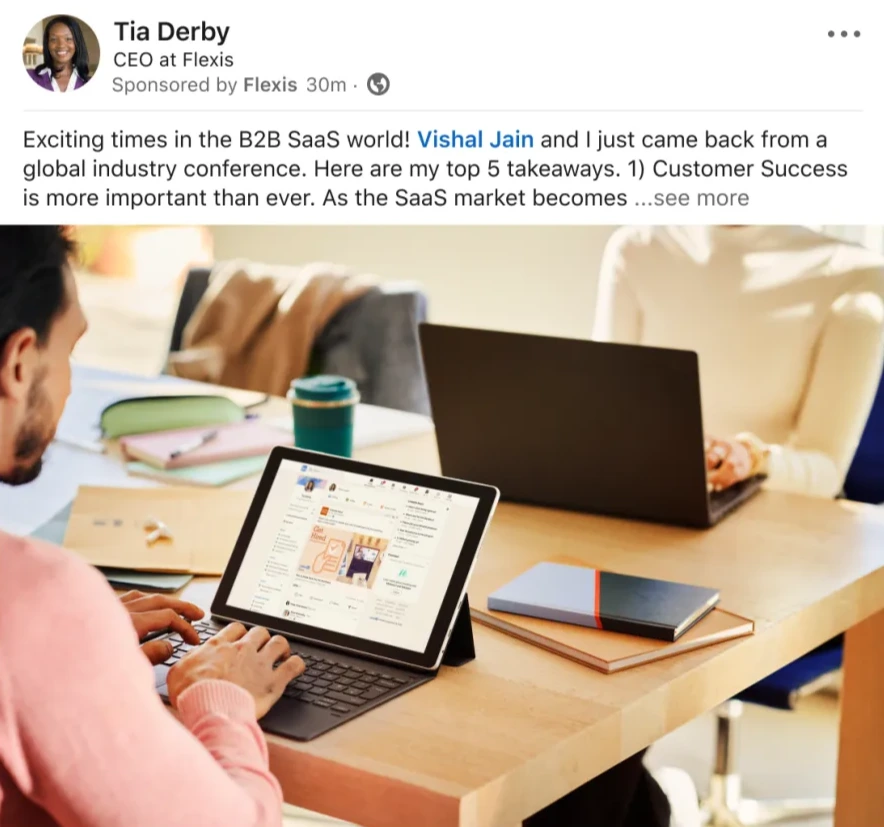
Example of a Thought Leadership Ad
7. LinkedIn audience network
The LinkedIn Audience Network expands ad reach beyond LinkedIn to partner websites and mobile apps.
Best use cases
- Brand awareness campaigns needing extended reach.
- Multi-channel retargeting to maintain visibility.
Best practices
- Monitor placement performance to ensure quality traffic.
- Use exclusions to avoid irrelevant placements.
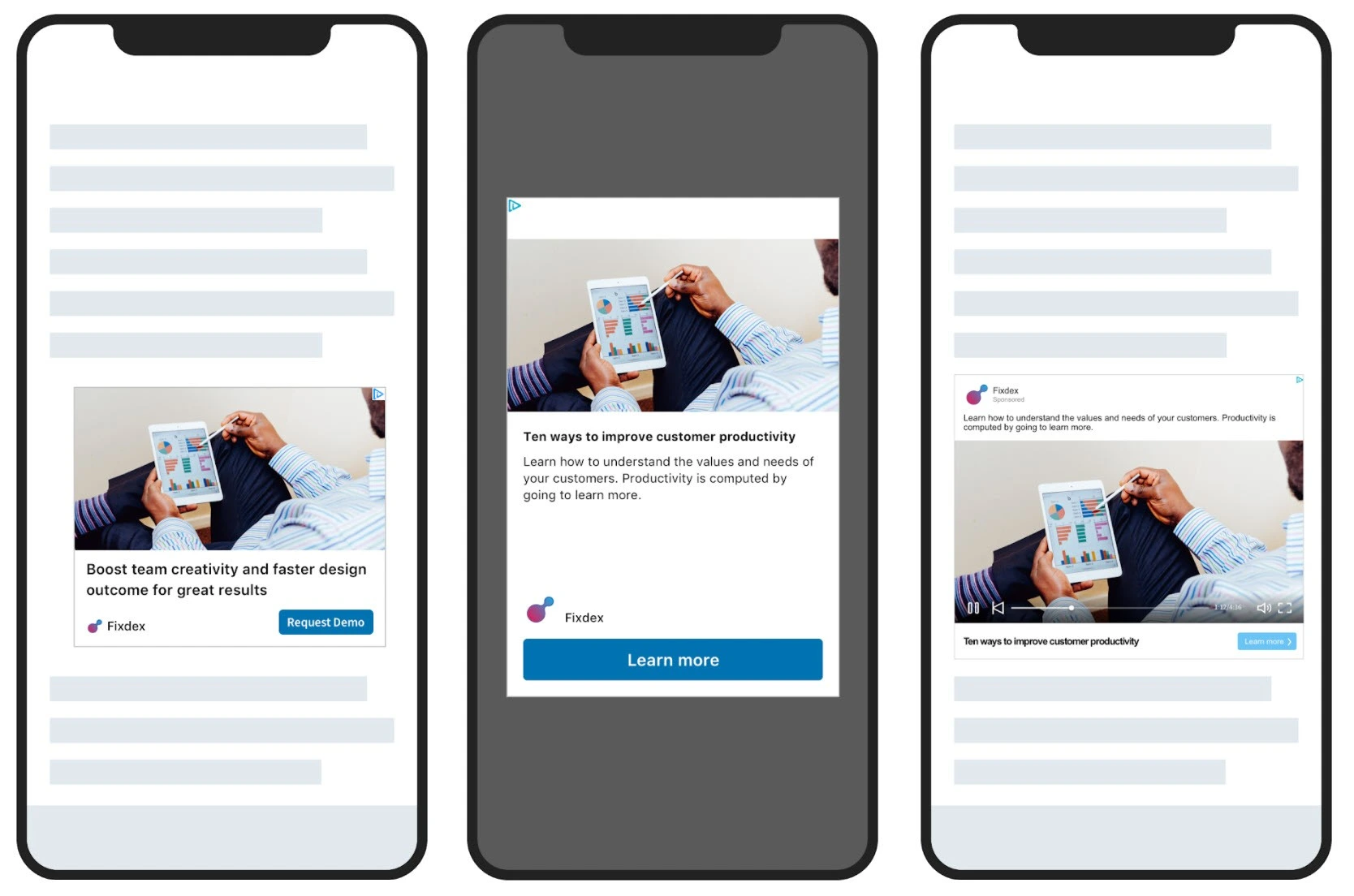
LinkedIn Audience Network
Understanding the right ad type is the first step to success on LinkedIn Ads. However, choosing the correct targeting strategy, budget allocation, and optimization tactics will determine whether your campaigns drive ROI or become a costly experiment.
In the next sections, we will break down different LinkedIn audience targeting strategies.
LinkedIn audience targeting: strategies for accuracy and efficiency
One of the biggest mistakes advertisers make with LinkedIn Ads is assuming the platform works like Facebook or Google Ads. While those platforms rely on broad demographic data, LinkedIn’s power lies in its professional targeting capabilities. This allows you to zero in on decision-makers, specific industries, job roles, and even company sizes.
However, this power comes with a challenge. Many advertisers either:
- Go too broad — targeting an audience so large that they waste budget on people who will never convert.
- Go too narrow — restricting their reach so much that LinkedIn struggles to serve their ads effectively.
The secret to making ads profitable here is adopting a layered targeting approach — a strategic method that ensures your ads reach the right professionals while maintaining scale and efficiency.
Let’s break down the how-to’s.
How LinkedIn’s targeting works (and what most advertisers get wrong)
LinkedIn’s audience selection is built around professional attributes, giving advertisers the ability to target people based on different criterias:
| Targeting Criteria | Example |
| Job title and function | “Marketing Director” or “VP of Sales” |
| Seniority level | “Entry-level,” “Manager,” or “C-Suite” |
| Industry | “Financial Services,” “Information Technology,” or “Healthcare” |
| Company size | “11-50 employees” or “10,000+ employees” |
| Skills and interests | “SEO,” “Sales Leadership,” or “Data Analytics” |
Many advertisers make the mistake of only using job title targeting, thinking that will guarantee they’re reaching the right decision-makers. But job titles vary wildly across industries.
For example, a CMO at a SaaS startup might call themselves a "Head of Growth," while at a Fortune 500 company, they’d likely be a "VP of Marketing." If you only target "CMOs," you might miss highly relevant decision-makers who just have different job titles.
The only solution to this problem is to layer your targeting strategically to ensure relevance while maintaining reach.
The layered targeting framework
Instead of relying on one targeting filter, you should combine multiple audience attributes to create a high-intent, scalable audience. Here’s a step-by-step guide of implementing this method:
Step 1: Define the core professional attributes
Start by selecting broad but relevant criteria to ensure your audience includes key decision-makers.
Example: If you’re marketing a B2B sales automation tool, your initial targeting might look like this:
- Job Function: “Sales”
- Seniority: “Manager, Director, VP”
- Company Size: “200+ employees”
Why this works:
- Instead of only targeting “Sales Directors,” this approach includes Sales Managers who influence decisions and VPs who make the final call.
- By adding company size, you filter out companies that may not have the budget for your tool.
Step 2: Add secondary filters to refine the audience
Once you have a broad but relevant audience, refine it by adding additional layers.
For example, if your sales automation tool is designed specifically for SaaS companies, you can add:
- Industry: “Software & IT Services”
- Skills: “Sales Strategy, CRM, Pipeline Management”
Why this works:
- Instead of targeting all sales leaders, you’re now reaching only those in SaaS who have relevant expertise in sales strategy and CRM.
- This prevents wasting budget on professionals in irrelevant industries like retail or manufacturing.
Step 3: Exclude irrelevant audiences
One of the biggest leaks in LinkedIn ad budgets comes from showing ads to people who will never convert.
Here’s how to fix that with exclusions:
- Exclude entry-level and intern roles if your solution requires executive buy-in.
- Exclude job functions that aren’t relevant (e.g., if you're selling HR software, exclude IT and engineering roles).
- Exclude small businesses if your product is enterprise-level.
Here’s an example: If your software costs $30,000 per year, you don’t want ads showing to small startups with 10 employees who can’t afford it. Instead, set company size filters to 200+ employees.
Step 4: Use retargeting to maximize conversions
Once you’ve defined your ideal audience, use LinkedIn’s Matched Audiences to create a multi-touch ad strategy:
- Website retargeting: Show ads to users who visited your landing page but didn’t convert.
- Lead list retargeting: Upload email lists of past leads and nurture them with fresh ads.
- Lookalike audiences: Expand reach by finding users similar to your best customers.
- Custom list targeting: Upload a list of known contacts—such as existing customers, high-intent leads, or past event attendees—and serve them targeted ads based on their stage in the funnel.
Examples: Audience combinations for high-performing LinkedIn campaigns
To help you apply this layered targeting approach, here are real-world audience setups that work for different LinkedIn campaigns.
Example 1: B2B SaaS lead generation (Webinar or Whitepaper Download)
| Targeting Criteria | Selection |
|---|---|
| Job Function | Marketing |
| Seniority | Manager, Director, VP |
| Industry | Software & IT Services |
| Company Size | 200+ employees |
| Skills | Demand Generation, Digital Marketing, Growth Hacking |
This works because:
- This excludes junior marketers who don’t have decision-making power.
- It focuses on professionals in SaaS, where demand for growth marketing content is high.
Example 2: Enterprise sales prospecting (ABM Campaign)
| Targeting Criteria | Selection |
|---|---|
| Company Name | [Upload list of target accounts] |
| Job Titles | VP of Sales, Chief Revenue Officer, Head of Sales Operations |
| Company Size | 500+ employees |
Why this works:
- By using account-based targeting, your ads are only shown to decision-makers in pre-selected companies.
- Company size ensures you’re only targeting large organizations that can afford your solution.
Example 3: Recruitment advertising (Hiring for a technical role)
| Targeting Criteria | Selection |
|---|---|
| Job Function | Engineering |
| Skills | Python, Machine Learning, AI Development |
| Seniority | Entry-Level to Mid-Level |
| Company Size | Any |
This works because:
- Instead of showing your job ad to all engineers, it specifically targets those with machine learning expertise.
- By including entry to mid-level seniority, it avoids wasting budget on CTOs or Senior Architects who wouldn’t apply for the role.
If done right, LinkedIn’s targeting system can generate incredibly high-quality leads that are ready to convert. But if done wrong, you’ll end up paying $20 per click for traffic that never turns into customers.
Now that you’ve learned how to structure LinkedIn audiences for maximum ROI, it’s time to get into ad creative best practices. Because even the best audience targeting won’t work if your ad itself is weak.
LinkedIn ad creative best practices
The biggest challenge with LinkedIn advertising is that people are not on LinkedIn to browse ads. They’re checking updates from their network, looking at industry news, or engaging with professional content. Your ad needs to interrupt that scroll in a natural way while delivering a compelling reason for the user to engage.
To capture the attention of LinkedIn users effectively:
- Your ad needs to feel useful, insightful, or educational WITHOUT being overly promotional.
- B2B professionals respond best to problem-solving headlines rather than generic sales pitches.
- Calls-to-action (CTAs) should be clear and low-friction (e.g., “Download the Playbook” instead of “Buy Now”).
Many advertisers overcomplicate their LinkedIn Ads with wordy, abstract, or vague messaging. But they need to remember that the audience of this platform are very busy. If they don’t immediately understand what you’re offering, they will scroll past your ad.
The four-second rule for better LinkedIn ad creative
LinkedIn users scroll fast. You have about four seconds to convince them to stop and engage with your ad.
Here’s how to grab their attention instantly:
| Tactic | Execution tips |
| Start with a strong, problem-focused headline |
|
| Use engaging, high-contrast visuals |
|
| Include a clear call-to-action (CTA) |
|
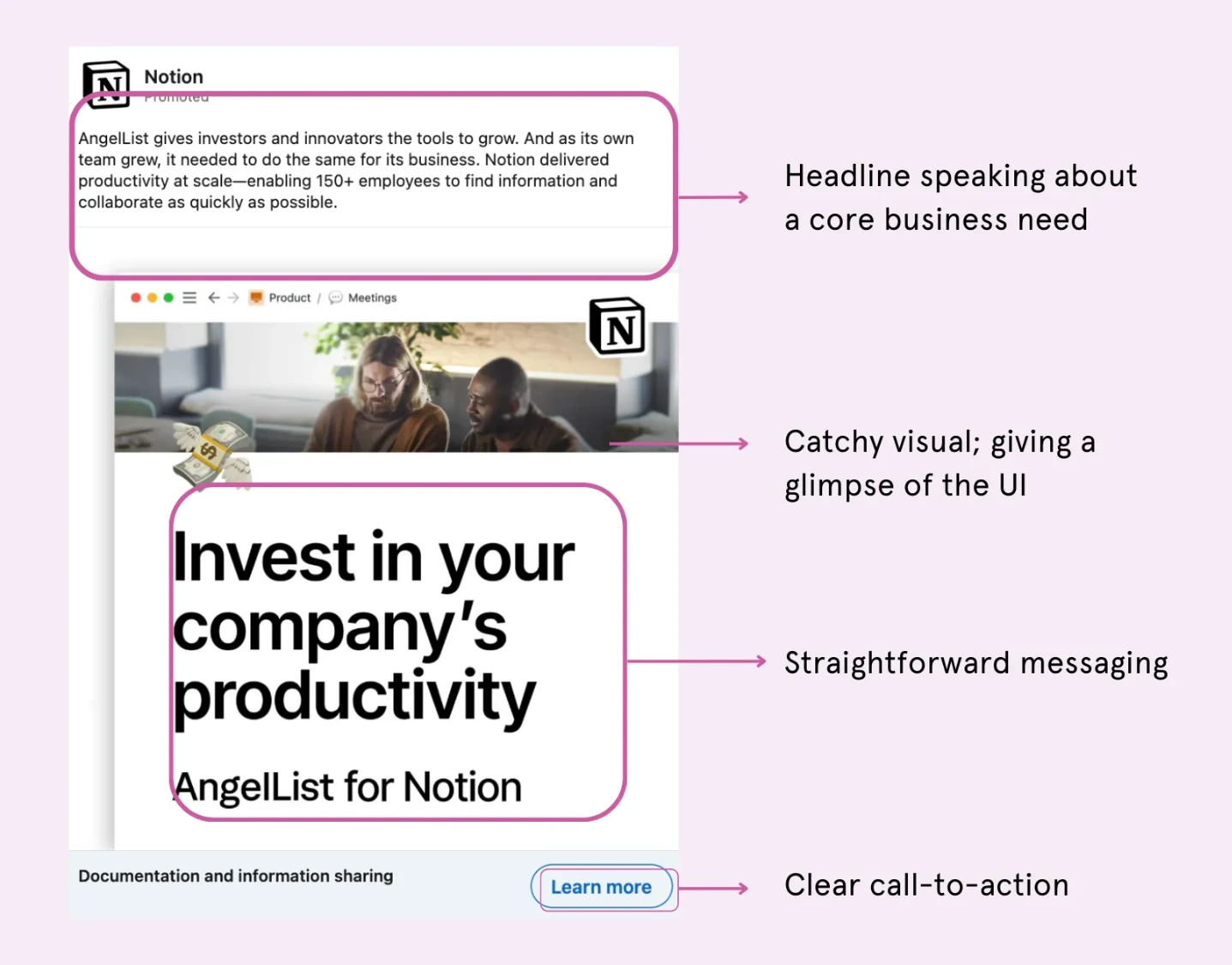
Anatomy of an ideal LinkedIn Ad
How to write high-converting ad copy
There are three key elements that determine whether your LinkedIn ad copy will convert:
Element 1: Headline (First Line of the Ad)
- This should grab attention and highlight the core value proposition.
- Keep it under 150 characters for readability.
Here are some winning formulas for LinkedIn ad headlines:
- Problem + Solution: “Struggling with lead generation? This guide will show you how to fix it.”
- Stat-Based Hook: “89% of marketers say LinkedIn is their top B2B platform. Here’s why.”
- Direct Question: “Are you paying too much for LinkedIn Ads?”
Element 2: Description (Main Body Text)
- This should expand on the headline and explain why your offer is valuable.
- Use bullet points when possible to improve readability.
Here’s a quick example of a weak description:
“Our software helps businesses automate lead generation. Click here to learn more.”
And another example of a strong description:
“Are you still manually tracking leads? Automate your pipeline and increase conversion rates by 40% with [Product Name].
🚀 Automate your outreach and free up your sales team
📊 Get real-time insights into lead performance
📉 Cut customer acquisition costs by 30%”
Element 3: Call-to-Action (CTA)
- The CTA should reinforce the value proposition and create urgency.
- Always test multiple CTAs (e.g., “Claim Your Spot” vs. “Download Now”).
Here are some CTA examples that work and why:
- “Download the Free Playbook”: Best for lead generation campaigns.
- “Get a Personalized Demo”: Best for enterprise SaaS.
- “Claim Your Free Trial”: Best for product-driven campaigns.
How to design high-performing LinkedIn ad visuals
Your ad creative is the first thing users notice—even before they read the copy. A compelling image or video can increase engagement rates by up to 200%.
Here’s what works best for LinkedIn Ads:
| Tactic | Best practice |
| Use high-contrast colors |
|
| Show human faces in images |
|
| Use motion in videos |
|
Here’s an example of a video ad script that has the potential to bring in conversions:
- First 3 seconds: “Are your LinkedIn Ads wasting money?”
- Next 5-10 seconds: Show a real-life example of someone struggling with ad costs.
- Final 10 seconds: Show how your product or service solves the problem with a CTA.
Examples of winning LinkedIn ad examples
Here are some real-world LinkedIn Ads that performed exceptionally well and why they worked.

Mixpanel leverages customer portfolio to build credibility
Example 1: Mixpanel
- Ad format: Sponsored image ad
- Ad objective: Lead generation
- What we can learn from this: Social proof with well-known brands builds trust and credibility.

Dreamdata takes advantage of the insightful voice of the employees
Example 2: Dreamdata
- Ad format: Thought leadership ad (video)
- Ad objective: Brand awareness
- What we can learn from this: Using customer testimonials from industry leaders builds trust and reinforces product value. Copy can be crafted in a way to provoke the user to spend more.

Clay uses customer testimonial to drive conversion
Example 3: Clay
- Ad format: Single image ad
- Ad objective: Lead generation
- What we can learn from this: Customer testimonials with specific transformation stories make the product’s impact tangible and persuasive
Measuring LinkedIn ad performance and optimization techniques
Launching a LinkedIn Ads campaign is just the beginning. If you want to maximize your return on investment (ROI), you need to track performance, analyze key metrics, and continuously optimize your ads.
Many advertisers make the mistake of judging success solely on clicks and impressions. But these numbers don’t always translate to revenue. LinkedIn advertising can be expensive, and if you're not measuring the right performance indicators, you could be wasting thousands of dollars on unqualified traffic.
Key LinkedIn Ads metrics
Here’s a breakdown of the most important LinkedIn Ads metrics and how to interpret them:
| Metric | What It Means | Why It Matters |
|---|---|---|
| CTR (Click-Through Rate) | Percentage of users who click on your ad | Indicates ad engagement and message relevance |
| Conversion Rate | Percentage of clicks that result in a lead, signup, or sale | Shows if your ad is attracting qualified users |
| CPL (Cost Per Lead) | Total ad spend ÷ number of leads generated | Measures efficiency of lead generation efforts |
| Cost Per Click (CPC) | Total ad spend ÷ number of clicks | Determines cost-efficiency of your ads |
| Engagement Rate | Clicks, likes, shares, and comments per impression | Helps evaluate the strength of your content |
| Pipeline Influence | % of deals influenced by LinkedIn ads | Tracks how ads contribute to revenue |
Why LinkedIn Ads underperform (And how to fix them)
If your LinkedIn Ads aren’t delivering the results you expected, here are some common issues and how to troubleshoot them:
| Issue | Problem | Possible Causes | Fix |
|---|---|---|---|
| High CPC but low conversions | Ads get clicks but don’t convert into leads or customers. |
|
|
| Low CTR and poor ad engagement | People scroll past your ad without clicking. |
|
|
| High impressions but low engagement | Ads are seen by many, but no one interacts. |
|
|
Advanced LinkedIn advertising strategies for maximizing ROI
Once you’ve established a solid LinkedIn Ads foundation, the next step is scaling and optimizing efficiently while maintaining low cost-per-lead (CPL) and high engagement rates. Here are some ways to do it effectively:
1. A/B test LinkedIn Ads to continuously improve performance
A/B testing is essential for refining LinkedIn Ads over time with small improvements. Some steps you can follow:
- Test one variable at a time — For example, keep the image the same but test different headlines.
- Let tests run for at least 7 days — LinkedIn’s algorithm needs time to optimize performance.
- Scale winning variations — Pause underperforming ads and allocate budget to high-converting creatives.
2. Optimize bidding strategy to reduce CPC without losing conversions
LinkedIn’s maximum delivery bidding often leads to higher CPCs than necessary. Instead, use:
- Manual CPC bidding — Start below LinkedIn’s suggested bid range to control costs.
- Cost-per-conversion bidding — If available, prioritize actual lead generation over clicks.
- Monitor cost trends weekly — Adjust bids based on performance instead of setting and forgetting them.
So, if LinkedIn suggests $15 per click, start at $12 CPC and gradually increase only if necessary.
3. Lower LinkedIn Ads costs without sacrificing quality
Reducing LinkedIn Ads costs isn’t just about lowering bids—it’s about increasing efficiency in ad targeting, creatives, and user experience.
- Refine audience targeting — Exclude small businesses if selling to enterprises.
- Improve landing page experience — Faster load times and clear CTAs increase conversion rates.
- Use LinkedIn Lead Gen Forms — They can reduce CPL by 40% compared to external landing pages.
4. Retarget high-intent users with multi-touch campaigns
Retargeting is one of the highest-ROI LinkedIn strategies because it focuses on warm leads. You can:
- Create website retargeting audiences for visitors who engaged but didn’t convert.
- Use engagement retargeting to re-engage users who clicked but didn’t take action.
- Show different content based on intent — Retarget top-funnel users with educational content and bottom-funnel users with demo offers.
5. Use lookalike audiences to expand reach efficiently
Lookalike audiences help you find new leads that resemble your best customers, improving lead quality while scaling. Hence:
- Create lookalike audiences from high-intent website visitors or past leads.
- Refine by industry, job function, and seniority to avoid irrelevant matches.
- Test different audience sizes — A 1% lookalike is more precise, while a 5% lookalike provides broader reach.
6. Scale LinkedIn Ads without increasing cost per lead (CPL)
Scaling LinkedIn Ads requires some tactics that will help you avoid burning your marketing budget:
- Increase budget incrementally — Avoid sudden jumps that disrupt performance.
- Scale winning audience segments first — Expand to new job titles or industries that performed well.
- Test ad frequency — If CTR drops significantly, refresh creatives instead of increasing spend.
7. Use AI and automation to improve ad efficiency
AI and automation tools can streamline LinkedIn Ads management, reduce manual work, and improve performance. Here’s what you can do:
- Use automated rules to pause underperforming ads and allocate budget to top performers.
- Leverage LinkedIn’s AI-driven recommendations for bidding and targeting improvements.
- Integrate with CRM and marketing automation tools to track leads beyond LinkedIn Ads.
8. Optimize LinkedIn Ads for mobile users
Over 57% of LinkedIn users access the platform via mobile, so ads must be mobile-friendly. That’s why:
- Keep headlines short (under 150 characters) for better readability on small screens.
- Use high-contrast visuals to ensure clarity on mobile devices.
- Test ad creatives on mobile first before launching a campaign at scale.
FAQ
How can I find competitor ads on LinkedIn for free?
Is LinkedIn advertising only meant for B2B brands?
Final thoughts
LinkedIn Ads is one of the most powerful tools for B2B marketing, but it’s not a platform where you can afford to guess. The high costs and complex targeting system mean that every campaign must be built with precision: from ad format selection to audience segmentation and creative execution. Without the right approach, budgets drain fast, and conversions remain low.
For startups and small businesses, navigating LinkedIn Ads without experience can be an expensive experiment. Many companies try to manage it in-house, only to burn through budgets without seeing real returns. This is where outsourcing to a specialized LinkedIn marketing agency makes sense. This shouldn’t be seen as an expense but an efficiency multiplier. An expert team can fine-tune targeting, craft compelling ads, and optimize campaigns to maximize ROI without the trial-and-error that often drains in-house efforts. Here’s a list of some such expert teams.
At the end of the day, whether you’re scaling in-house or outsourcing, the companies that succeed are those that commit to strategy, execution, and relentless optimization. The question is: which option would you choose?

